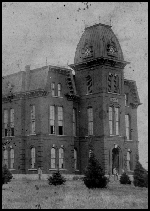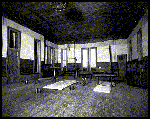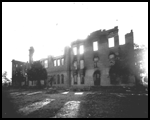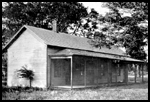Lost Buildings |
||
The first main building, "Old Main," was a two-story brick structure measuring 42 by 74 feet. It housed administrative offices, classrooms and a library. It was the focal point of what was then a very small campus. By the end of the first decade in Sherman, neither the building nor the grounds showed many improvements or exuded much promise for future growth. The college had exhausted its energies and assets just to remain open during the difficult 1880s. |
||
 1 September 1889 - "Dr. Luckett met me at
the depot Saturday afternoon and we walked a half mile up College Hill to our stopping
place, passing corn field, cotton field, orchard, weed field, apparently out in the
country beyond the final limit of street and houses,--on to a jail-like brick building
with wire fence about its ten acre campus, broken window glass and dilapidated air
generally. 1 September 1889 - "Dr. Luckett met me at
the depot Saturday afternoon and we walked a half mile up College Hill to our stopping
place, passing corn field, cotton field, orchard, weed field, apparently out in the
country beyond the final limit of street and houses,--on to a jail-like brick building
with wire fence about its ten acre campus, broken window glass and dilapidated air
generally.A few lonesome cottages about it--one hut on the lot where Dr. Luckett afterwards built; another rude, box house then occupied by W. G. Venable, Sr., where Dr. Luckett and his wife, a most elegant lady, were boarding and where I found my meals; another newer and somewhat more pretentious cottage, a block or more away, owned by Mrs. Lyle, Mr. Venable’s widowed daughter, where I met her brother, Sidney Venable, a graduate of last year, and where I engaged board for the coming year, provided I would occupy a room with a student, Mr. Gooch, a two hundred pounder; another little cottage or two on the South side of the campus and nothing more." --Davis Foute Eagleton In the 1880s, the address for Austin College was listed in the Sherman City Directory as "the east end of College Street, northeast part of the city. By 1892, it was given as the "north side of E. College between Hurt and Grand Avenue. Not until Sherman Hall was built in 1914 did the college have a Grand Avenue address. Jewel Link Luckett, wife of President Samuel Luckett, offered $2000 to complete the addition of a west wing, provided the Trustees pledged to finish it. In June, 1891, the Board of Trustees empowered the Executive Committee to devote $4000 for this purpose. In 1894, F. M. Files, of Files Valley, Texas, donated a cotton compress to the school. Proceeds from its sale were used for the erection of an east wing. Trustee, J. M. Thompson, donated $500 worth of lumber to be used in the building. The upper stories of these wings were furnished as meeting halls for literary societies. |
||
|
|
||
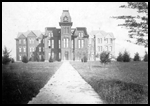 |
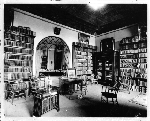 |
|
December 1895 - "The Files Hall and the East wing have been completed. Now each society has a hall of its own and society pride is soon manifest. The library has also been overhauled and renovated. An arch has been cut between the library room and the North room, and the whole called "The Chadwick Memorial Hall."-- Prof. Davis Foute Eagleton. |
||
|
|
||
The students had lobbied for years for a gymnasium, but not until the presidency of Rev. Thornton R. Sampson (1897-1899), a physical fitness enthusiast, did the dream become reality.
|
||
|
|
||
Old Main disappeared from the campus scene in a blaze of glory on a winter night in 1913, the victim of a disgruntled student’s wrath. Its destruction altered the complexion of the campus dramatically by robbing it of a focal point. |
||
"Before the fire had begun to die out, the Senior class called the student body together and they pledged themselves by classes in writing to stand by the Faculty and the College, and that no one would leave. The Faculty also met shortly after and unanimously decided to continue college work the next day as usual, meeting their classes in places designated. Probably not another institution in the State could have done this. But the old College building is gone forever !!!" -- Davis Foute Eagleton. |
||
|
|
||
This drawing of the campus limits by Walter E. Long, Class of 1910, represents the campus bounded by College Street on the south, Richards Street on the north, Hurt Street (Eagleton) on the west, and Grand Avenue on the east. Four one story plank dormitories, sketched at the top of the drawing, were constructed in the 1890s with four rooms each and a common porch. Each room had an outside door on the south side. The chalk line, marked off for military drill (1889-1897), remained visible as late as 1907. |
||
|
|
||
One of the major problems facing the college during its first quarter century in Sherman was a lack of housing for boarding students. Boarding houses were the first accommodations for students "from a distance," and those eventually acquired by the college, such as Eagleton House and Lee House, continued to provide housing for AC students into the second half of the twentieth century. |
||
 |
||
